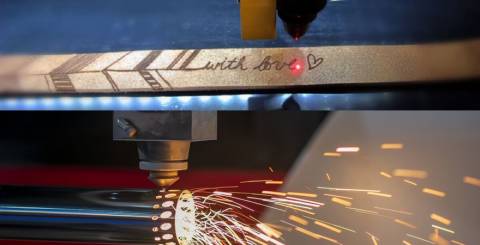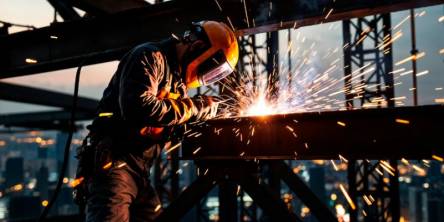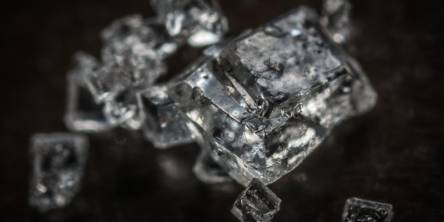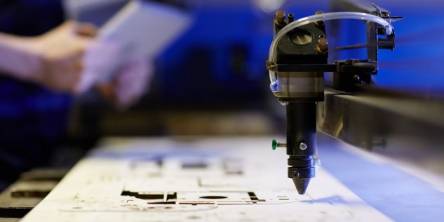Laser Engraver Vs. Laser Cutting

Although the terms "laser engraver" and "laser cutter" are often used in the same context, there are a few differences between them. People have a huge misconception regarding the functions of both terms. In the present world scenario, laser machines can cut as well as engrave single-handedly. The major difference lies in their use. Based on that, it is either called a laser engraver or a laser cutter.
Although you can achieve both tasks, certain lasers come with more features specifically designed for laser cutting or engraving. To have an in-depth understanding, let us begin with their functioning.
Working of the Laser Engraver
A laser engraver has been optimized to exhibit high-quality engraving as compared to other cutting machines specifically designed for cutting. The laser engraver processes a PNG or JPG graphic, picture, or shape. Like an ordinary printer, the laser engraver works by removing the material to form depths horizontally, line-wise, and pointwise. This process is referred to as "grid engraving.
A plethora of designs can be engraved on any surface or shape, such as pictures, inlays, logos, photos, and stamps, ranging from fine to bold lettering. One point to be noted: the surface area can be oxidized when the object's surface is breaking.
Working of the Laser Cutter
Mostly, people confuse this with the laser engraver. However, this is different. Laser cutting works by separating an entire piece in a certain shape out of the material. It is also known as "thermal separation" because the laser heat is used to cut through.
The laser received EPS, CDR, or AL file is sent for design identification. It follows that design and cuts out a piece of material using the laser beam. The machines specifically designed for this purpose run at a much faster pace as compared to ordinary engraving machines.
Carbon dioxide lasers are used for laser cutting as they only engage with the material instead of the pigment inside. During the process, more focus is put on acquiring smooth cuts for well-polished edges.
What is the major difference between the two?
The one and only essential difference between a laser engraver machine and a laser cutting machine lies in its lens. In the case of the laser engraver machine, the lens's focal length is shorter to give a detailed spot while working on any material. This results in high-quality engraved products like photographic images, for instance.
On the other hand, laser cutting machines are equipped with a longer focal length of the lens. This delivers better height variations and manufactures smooth edges. This is applicable for cutting thick materials as the laser cutter will bring down the angle of the sloped edges. The machine works best when applied to materials with a large depth, i.e., 20mm or more.
Here are three factors you should consider while trying to decide which one will work best for you: Using a laser engraver or laser cutter
- Figure out your primary requirement, i.e., cutting or engraving.
- Pay attention to the size of the material
- Identify the kind of materials you want to work on.
Conclusion
Apart from the two varieties mentioned above—laser engraver and laser cutter, there are several other ways of altering the structure of a material, such as laser marking, etching, etc. The introduction of the laser has made things easier than ever. Now, you can expect to engrave or cut on a variety of materials with a professional finish. All you need to do is follow certain steps.
Carbon dioxide can successfully engrave materials of varying thicknesses like MDF, card or paper, acrylic, and many more. When it comes to cutting metals, several technologies are available, such as high-powered CO2 lasers, plasma cutters, waterjet machines, and fiber lasers. Identify your requirements and make your choice wisely.
Similar Articles
When you see a steel ship in the harbor, the first impression is usually sheer scale.
Explore CNC turning—its components, process, benefits, applications, and future trends shaping modern precision manufacturing in various industries.
In the competitive industry of car manufacturing, attaining exceptional performance along with an innovative design needs the incorporation of modern manufacturing technologies
Facing delays, quality issues, or supply chain problems in hardware manufacturing? Learn the top 7 challenges—and practical fixes—to streamline production.
In the rapidly advancing landscape of high-tech manufacturing, electronics, and materials science, diamonds are no longer just gemstones they’re high-performance materials redefining what’s possible in technology.
A business in the manufacturing industry today has to ensure that it chooses the precision-engineered components suppliers keenly since the competition is very stiff
Selective Laser Sintering, or SLS, has established itself as one of the most reliable and widely used 3D printing technologies. This method is valued for its ability to produce complex, durable, and high-quality parts without the constraints of traditional manufacturing.
In the retail and display industry, the visual appeal of products is paramount. Customers are constantly drawn to displays that are not only eye-catching but also provide an immersive experience.
As previously established, CO2 laser technology operates by shining a high-power infrared beam on a mixture of gas that contains carbon dioxide, nitrogen, and helium. This technology is well known for the fact that it is able to engrave onto a variety of materials such as wood, glass, plastic, leather, and even some metals with high precision and without contact.









